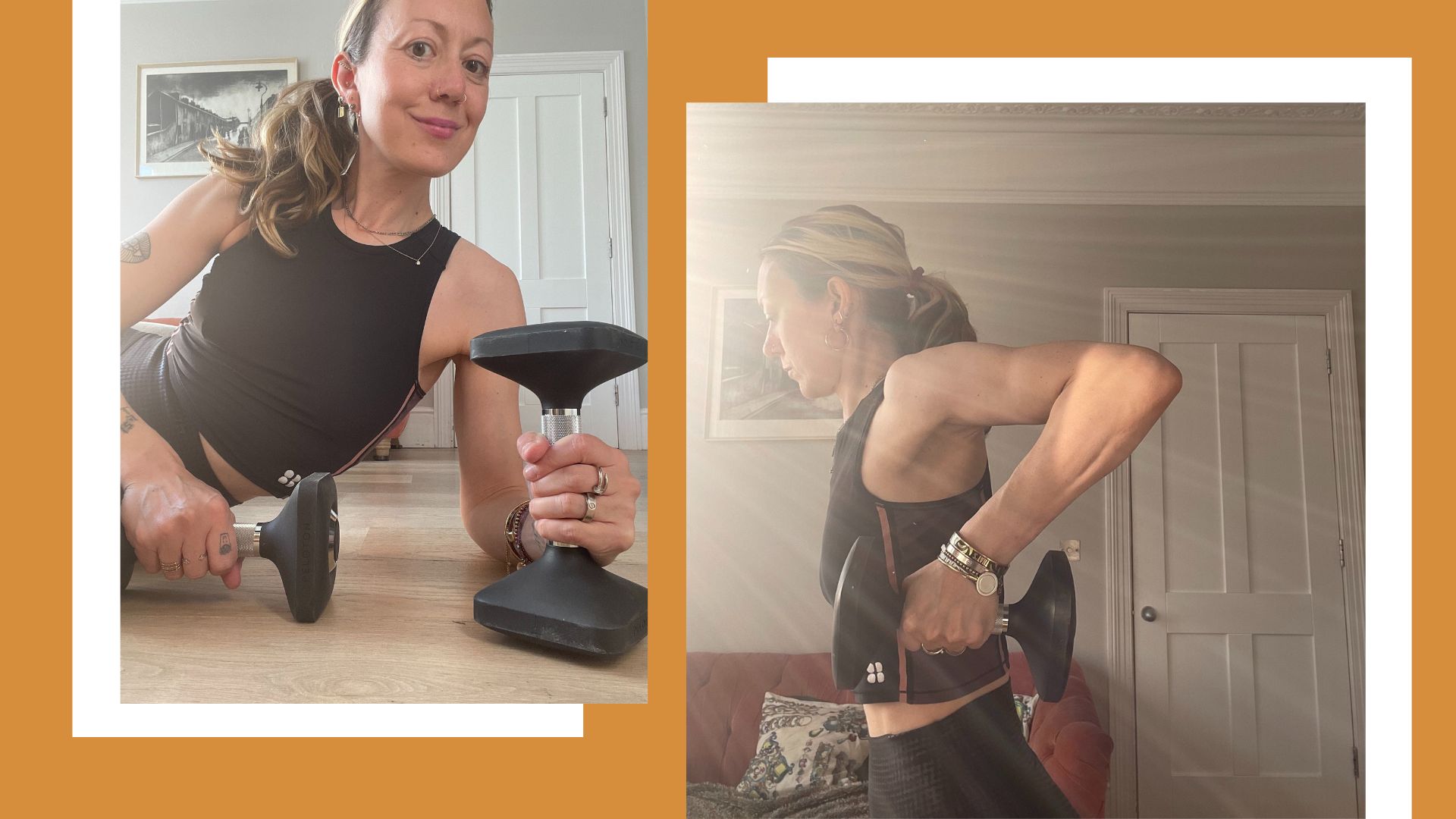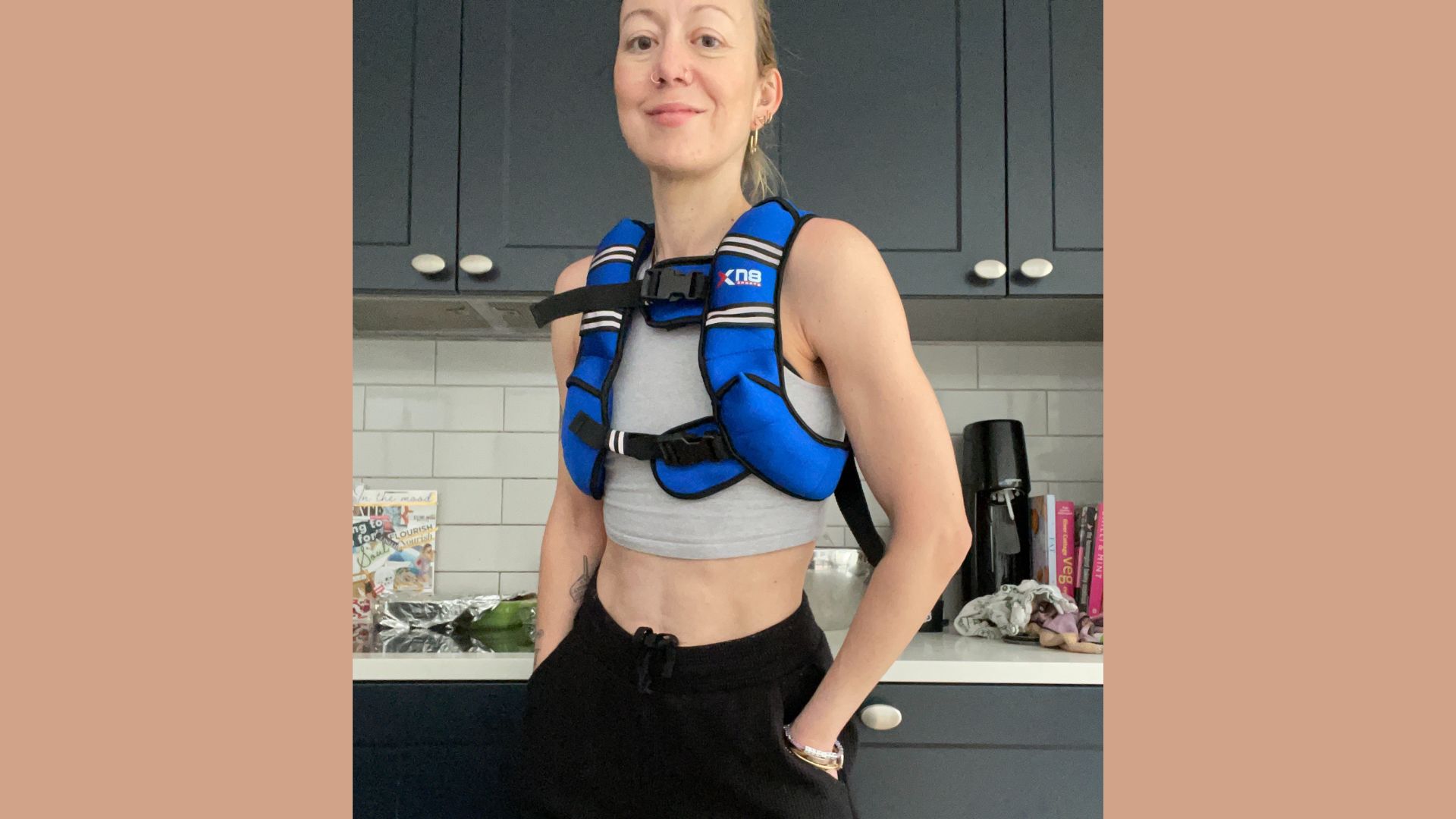
Strength training is one of the main activities perimenopausal women are encouraged to take up - but the gym isn't for everyone. Luckily, other types of strength training are available too. Here, writer Jen Barton reveals how she learnt to love lifting again by throwing out the rulebook.
A specific image comes to mind when I think of strength training. I’m in my early 20 in a gym in my hometown of Manhattan. I'm surrounded by equipment I have no idea how to use. A super-muscly man is barking orders at me. “Don’t stop! Keep lifting!” I want to run away, cry, disappear. My arms are killing me. The weights are too heavy. I would rather be anywhere else. This isn’t a recurring nightmare though - it’s a memory. A core memory I’m pretty sure my brain filed under the heading: “This is why we never lift weights.”
I assumed the problem was me, rather than the training style, and I was certain that I hated weightlifting after the experience - an opinion that remained until fairly recently. In my 40s, I found my way back. My style isn’t conventional and my path doesn’t look like most people’s, but it works for me and if you've had a similar negative experience or want to exercise outside the gym, it may work for you too.
Types of strength training
1. Exercise snacking
I found gyms off-putting in my early 20s when I was at peak fitness, after spending my teens training as a classical ballet dancer, and by the time I was ready to get back into fitness in my 30s, gyms seemed possibly intimidating. Four babies and knee surgery hadn't left me in great shape. My core was a mess, I had hip problems and pains in my other leg from overcompensating for my bad knee, and I didn’t have the lung capacity to run after a bus without gasping for air.
I knew I had to do something. So, on a doctor's recommendation, I started spinning at home during the pandemic and found my enthusiasm for workouts slowly returning. But I still worried about doing anything beyond this - and I didn’t have the time or inclination to exercise for longer than 20 minutes. I didn't know it at the time but this 20-minute exercise burst is known as 'exercise snacking' - and it's a perfectly good way to get a daily dose of exercise into the day.
Joanna Train, a sport and exercise psychologist with Optimise Potential Sport, says it's a training method that works for many clients who say they don't have time to work out. "Going to the gym for an hour can be overwhelming, whereas fitting in 10 minutes at home regularly can help build a long-term habit. Working out from home also eliminates barriers like cost, accessibility, and time. With strength training, repetition and frequency are really important to build a habit."
I found this type of exercise was all about committing to moving my body instead of scrolling on my phone, for example. Nowadays, I squeeze in power walks while running errands, take a brain break with a 10 to 20-minute yoga class in my bedroom, and spend five minutes doing core exercises at home in front of the telly.
"Repetition and frequency are really important to build a habit."
2. Home workouts
I thought I enjoyed going to boutique fitness classes in gyms and studios before I started working out at home, but truthfully, I could never relax. I would stress about getting there on time, worry about the cost of each session, and feel like none of the thousands of fitness classes fit into my schedule.
I also have issues working out in front of other people. It makes me feel self-conscious rather than motivated - or worse, I get ultra-competitive and push myself to do things my body can’t manage.
This isn’t uncommon. As Maddy Weaver, a PT who trains her clients in London’s GYMPODS (private workout PODs kitted out with functional cardio and gym kit), explains: “Most of the commercial gym spaces tend to be quite male-dominated, and I think for a lot of people who are coming back to exercise, wanting to try strength training or new mums, there is this sense of ‘gym intimidation – gymtimidation.’”
A private space - like your living room, spare room, or back garden, improves your focus, so you can get your workout done. "A distraction-free environment is good at the beginning for people to take the time for themselves, to focus on what they’re doing, and not compare themselves to others,” she says.
Though my workouts happened at home alone, I had a guide and an online community via Peloton - one of the best strength training apps - and their Strength team, specifically Callie Gullickson. I gravitated towards Callie’s classes as her playlists felt fun rather than terrifying, and she was heavily pregnant while teaching. Seeing her lifting while six, seven, and eight months pregnant made me feel confident that I wouldn’t injure myself if I followed her instructions. She always showed modifications too, which was perfect for me as a newbie with a very-far-from-rock-solid core.
Once I got into a groove over days, weeks and months, my body started telling me when I was ready to take things to the next level. Otherwise known as progressive overload, I found could increase the weights and the number of reps I could do.
3. Barre and Pilates
I started my strength training journey at home by going to my comfort zone, aka low-impact, bodyweight-based strength training classes like barre and Pilates. As a former dancer, these felt like a homecoming of sorts, and I’d been doing Reformer and mat Pilates on and off since my teens, so I knew the moves by heart.
Both barre and mat Pilates are ideal for strength-training newbies like myself. They are types of strength training that focus on micro-movements and repetition, isolating specific muscle groups and primarily using body weight for resistance. You can do Pilates for strength training as the exercise also strengthens and elongates muscles. It can help with mobility, posture, injury prevention, and rehab too. Research by La Trobe University even found that Pilates not only positively impacted participants' core muscle strength, but did so while reducing chronic back pain.
Sticking to a routine felt manageable once I committed to 10 minutes of exercise daily, a few times a week. Within a couple of weeks, my sessions had become a non-negotiable.
4. Calisthenics
The stronger I started to feel, the more I wanted to challenge myself safely. So, I tried callisthenics - one of the types of strength training that uses body weight for resistance instead of equipment. I started integrating movements like crunches, heel taps and pushups, into my regimen, whenever I had a few spare minutes.
Callisthenics can improve posture, strength, and body composition in much the same way that a full-body Pilates workout and barre do, so it came relatively easy to me.
I quickly learned most of my strength training “knowledge” was rooted in false preconceptions. For example, callisthenics is big on balancing poses, like crow – which happens to be my favourite yoga pose. If only I’d questioned my assumption that strength training was worlds away from the type of exercise I’d enjoy, I might have started sooner.
"If only I’d questioned my assumption that strength training was worlds away from the type of exercise I’d enjoy"

5. Weighted vest
Part of my motivation to start strength training in my 40s was to do with my hormonal health. My perimenopause symptoms are intense and unpredictable so watching an interview with ob-gyn, Dr Mary Claire Haver, a menopause specialist and big-time advocate of weight and resistance training, had a profound impact on me.
Following her advice, I bought myself a weighted vest, which I wear out for walks and on the school run. Studies from Oregon State and the University of Gothenburg show that these vests, which have slim weights adding up to between 5kg and 20kg sewn in, can help with health concerns from weight loss to bone mass maintenance in older women.
A weighted vest isn't as noticeable as you might think and it's been so easy to incorporate one into my routine. I’m thinking about investing in a pair of Bala Bangles (i.e. ankle weights) now the summer's here as these are less noticeable - but almost as effective. Wrapped around each ankle, they help to engage muscles on the move.
A simple weighted vest like this one looks much like a running vest, so it'll blend easily into your activewear, and there's even a pocket to hold your phone. The ZELUS Weighted Vest offers weights from 5kg to 14kg too, so one for whatever level you're starting at.
Bala Bangles are designed to be lightweight (these are just 1lb each) and worn for a few hours at a time, offering gentle resistance as you run or walk. Cheaper alternatives are available but these high-quality weights can be worn on the ankle or wrist and have a simple closing mechanism.
Why strength training is beneficial
When women hit 40, there’s no shortage of experts recommending strength training for all sorts of reasons: to help reduce the risk of muscle loss, to strengthen bones and minimise the risk of osteoporosis, to boost brain health by releasing serotonin and dopamine, to limit back pain, to help with menopause symptoms, to help with menopausal weight gain...the list goes on and on.
"[With strength training], we're not going to feel so driven by the peaks and troughs of hormone imbalance," says PT Weaver. "I think that's been one of the really big benefits for lots of my clients."
One of the reasons why I love strength training so much is that I can see how it’s impacted other facets of my life. I’m more active now. I continue to lift weights and then some: I run multiple times a week, do walking meditation, stretch my body in yin yoga. It’s a virtuous circle of exercise for mind and body, and now that I’m committed, I don’t see myself ever stopping.
I jump out of bed most mornings, excited to move, cook, work out, and spend time with my kids. I feel like eating healthily and I haven’t had a sip of alcohol in a year.
For some people, the community and accountability that comes from working out in a group, or a gym environment, is unbeatable. But that’s not the only way. I’ve found my happy place by myself, but not alone, sun streaming through my windows, show tunes blasting from my phone as I practise skull crushers on my bedroom floor.
The good news is, you don't need to do strength training every day to reap the benefits of the activity. How often you should lift weights depends on your own goals, of course, but just two sessions of dedicated work a week is enough to build muscle - and once you get going, it's easy to keep going.





!["[T]he First and Fifth Amendments Require ICE to Provide Information About the Whereabouts of a Detained Person"](https://images.inkl.com/s3/publisher/cover/212/reason-cover.png?w=600)

